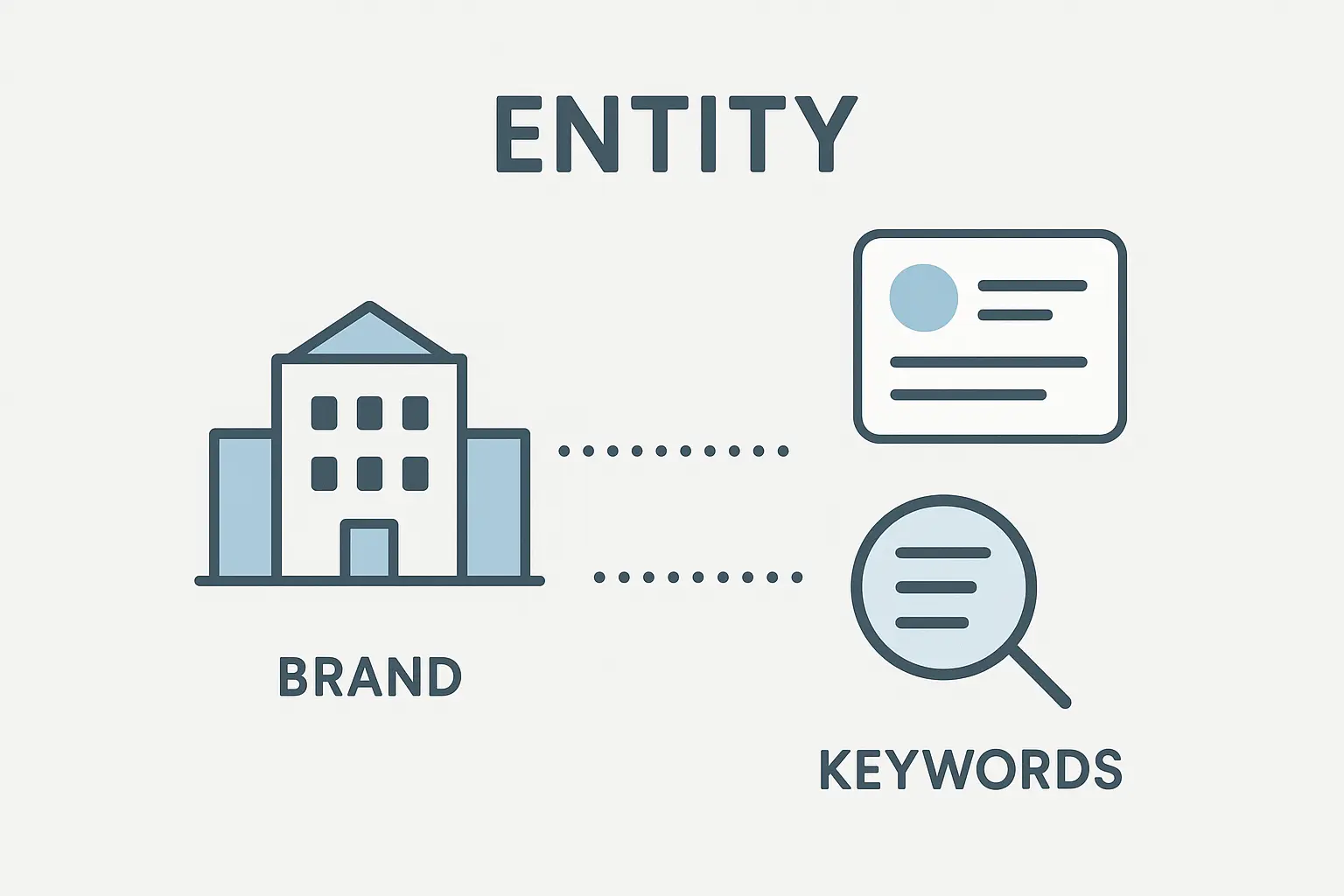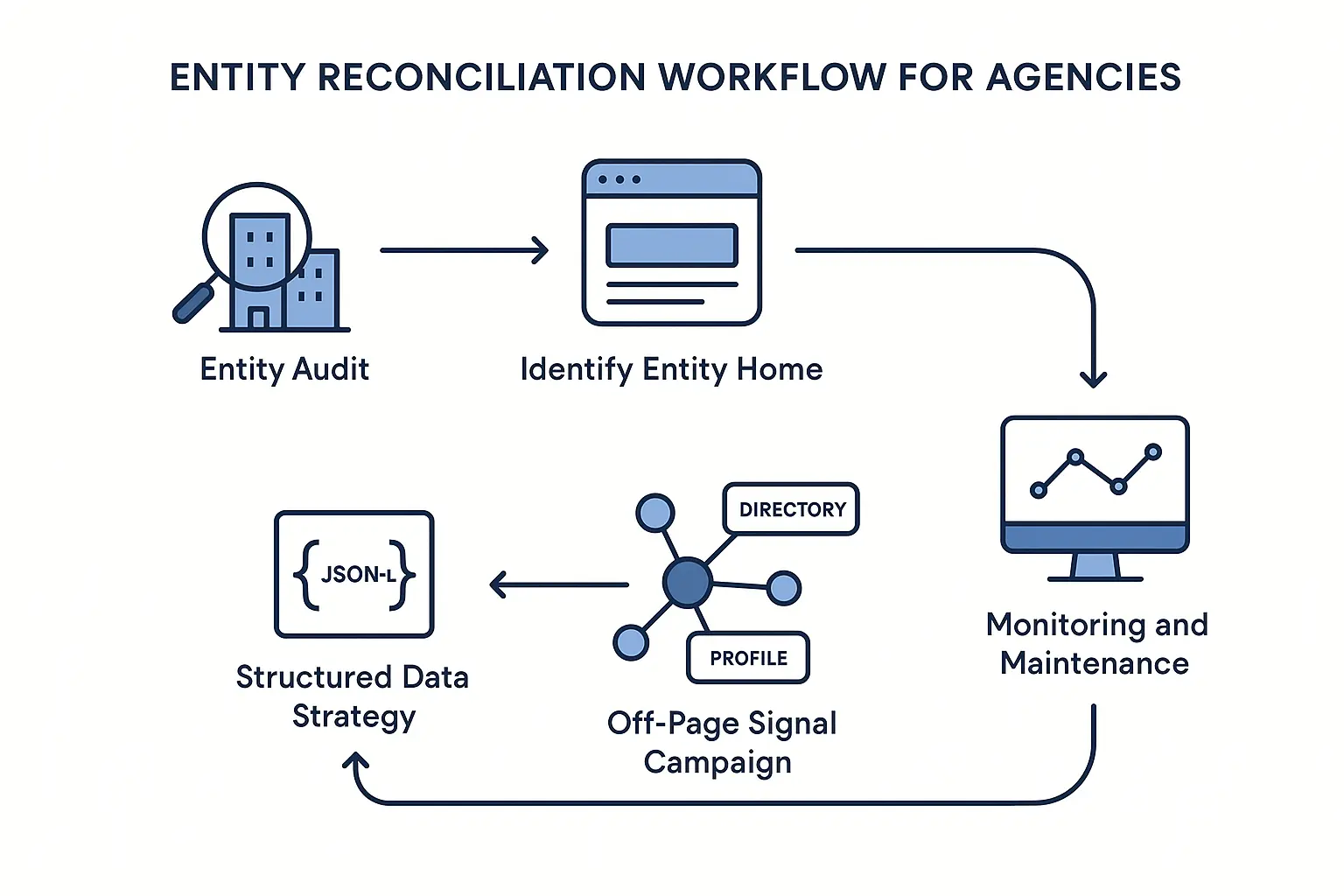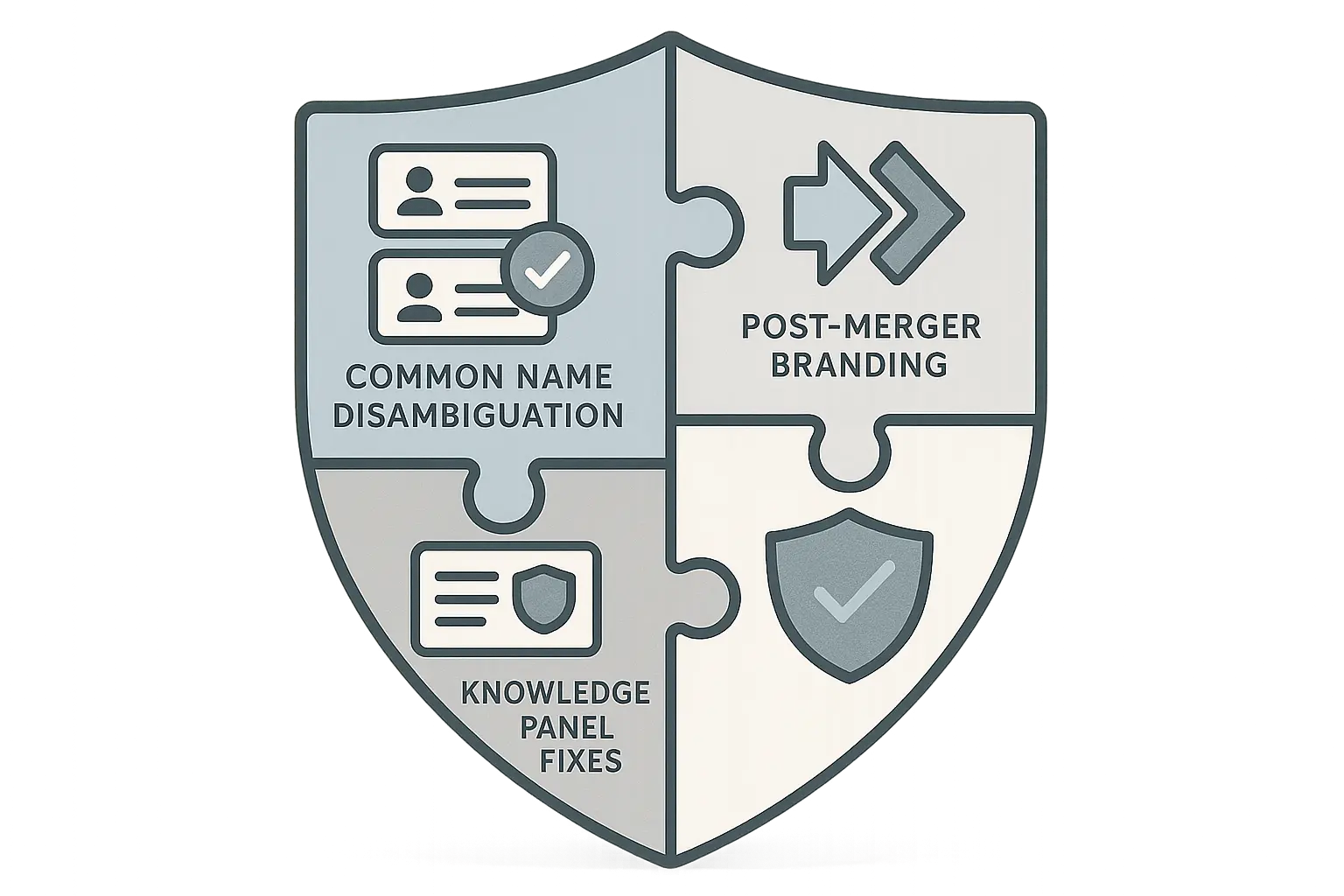Your agency just landed a promising new client, a fantastic local construction firm called “Apex Solutions.” But a quick search reveals a problem. There’s another “Apex Solutions” that’s a software startup two towns over, an “Apex Solar Solutions” in the next state, and a national logistics company called “Apex Global.”
To you, they’re distinct businesses. To Google, they’re a tangled mess of ambiguous signals.
This silent challenge can undermine even the best SEO campaigns. You can build incredible content and earn powerful links, but if Google isn’t 100% sure which “Apex Solutions” you’re referring to, your client’s authority gets diluted, their Knowledge Panel displays incorrect information, and their rankings ultimately suffer.
This is the world of entity reconciliation—the behind-the-scenes work of turning a vague brand name into a clear, distinct, and authoritative entity in Google’s eyes. For agencies, mastering this process, or partnering with someone who has, is the key to unlocking consistent results for clients with common names, complex histories, or post-merger identities.
What is an SEO Entity (and Why Does Google Care So Much?)
Let’s demystify this. Where SEO was once about keywords, today it’s about entities.
An entity is any unique, well-defined thing or concept: a person, a place, a company, a product, or an idea. It’s not just the string of letters “A-p-e-x,” but the actual, specific construction company located at 123 Main Street.
Google’s goal is to understand the world like a human does. It connects entities through its Knowledge Graph, a massive database of how things are related. When Google can confidently identify your client’s business as a unique entity, it can connect all the positive signals associated with it—reviews, news mentions, directory listings, social profiles—to one central hub.
This process is a critical part of building credibility. As Google’s own John Mueller has emphasized, establishing a clear entity is a cornerstone of demonstrating E-E-A-T (Experience, Expertise, Authoritativeness, and Trustworthiness). Without it, you’re essentially asking Google to trust a stranger.
The High Cost of Ambiguity: When Brand Signals Get Crossed
When brand signals are ambiguous, the consequences can be severe and frustrating. Your agency might be doing everything right, yet the client isn’t seeing the results they expect.
This ambiguity often arises from a few common scenarios:
- The Common Name Problem: Your client is “Synergy,” “Pioneer,” “Summit,” or another popular business name.
- The Merger & Acquisition Mess: “Smith & Jones Financial” merges to become “Innovate Wealth,” but decades of digital signals still point to the old brands.
- The Location Confusion: A dental practice with multiple locations, each with slight name variations, confuses Google about which one is the “main” entity.
- The Digital Doppelgänger: A competitor or unrelated business has a name so similar that Google struggles to tell them apart.
These situations create a ripple effect, leading to diluted search authority, incorrect information in the brand’s Knowledge Panel, and poor visibility in local map packs.
A business’s digital identity must be crystal clear. Research shows that 80% of consumers lose trust in local businesses that have inaccurate or inconsistent contact details and names online. If customers are confused, you can be sure Google is, too.
The Entity Reconciliation Workflow: Your Blueprint for Clarity
Fixing entity ambiguity isn’t a quick fix; it’s a systematic process of forging a consistent, authoritative digital footprint. Here’s a workflow you can adapt for your clients.
Step 1: Establish the Canonical “Source of Truth”
Every entity needs a home base. For a business, this is its official website. Your first job is to signal to Google, “This website is the definitive source of information for this specific company.”
The most powerful tool for this is Organization schema markup. This structured data, placed in the header of the website, acts like a digital business card for search engines. It explicitly states the business’s official name, logo, address, phone number, and social media profiles.
This foundational step ensures any other signals Google finds across the web can be cross-referenced back to the client’s site. As a core component of effective technical SEO audits for agencies, it sets the stage for everything that follows.

Step 2: Unify Your Digital Footprint (NAP+W Consistency)
Consistency is king. Every single mention of your client’s business online should match the information on their website. We’re talking about NAP+W:
- Name
- Address
- Phone Number
- Website
Comb through top-tier directories, social media profiles, and industry-specific citation sites (e.g., Avvo for lawyers, Houzz for contractors) and ensure the client’s information is identical everywhere. A “Street” here and an “St.” there can be enough to create a crack in the foundation.
Step 3: Implement Advanced Schema Markup
Once the basics are in place, you can use more advanced schema to create undeniable connections. The two most important properties for this are @id and sameAs.
- @id (Identifier): This creates a globally unique, permanent URL for the business entity. It’s like giving your client’s business a Social Security Number for the web. A common practice is to use the website’s homepage URL with a hash (#organization) at the end.
- sameAs: This property is the magic connector. Within your Organization schema, you use sameAs to link to other authoritative profiles that represent the exact same entity. This includes their official LinkedIn, X (Twitter), Facebook, Crunchbase, and even their Wikipedia page, if they have one.
You’re explicitly telling Google: “The company described here is the same as the one on this LinkedIn page, this Facebook profile, and this Wikidata entry.” This is a cornerstone of modern omnichannel growth SEO, as it connects brand signals from across the digital ecosystem.
Step 4: Reinforce with Content and Links
With your structured data foundation in place, every piece of content and every link becomes a reinforcing signal.
- Structured Citations: When your client is mentioned in an article, press release, or guest post, ensure the mention includes their full, correct brand name and, ideally, a link back to their website.
- Link Building: Every backlink from an authoritative source serves as a vote of confidence in your client’s entity. A focused white-label link building strategy helps accelerate Google’s understanding and trust.

The Agency Advantage: Scaling Entity Reconciliation Without Drowning in Detail
As an agency, you know this work is meticulous, time-consuming, and unforgiving. Manually auditing dozens of citations, writing precise JSON-LD schema, and ensuring consistency across hundreds of online properties for multiple clients is a recipe for burnout.
This is where a programmatic, white-label approach makes all the difference. By partnering with a fulfillment specialist, you can deploy a proven system to handle the granular execution while you focus on client strategy and growth. An effective partner can execute this entire workflow invisibly, delivering clear, consistent brand signals under your agency’s banner.
This model allows your agency to offer a sophisticated and critical service without the overhead of building an in-house team of specialists, freeing you to scale profitably.

Frequently Asked Questions (FAQ)
What’s the difference between an entity and a keyword?
A keyword is a string of text a user types into a search bar (e.g., “construction company near me”). An entity is the real-world thing Google connects to that query (e.g., the specific business “Apex Solutions” at 123 Main Street). Modern SEO focuses on building the authority of the entity, not just ranking for the keyword.
How long does it take for Google to reconcile an entity?
It varies. For a new business with a clean slate, it can be a matter of weeks. For a company that’s gone through a merger and has decades of conflicting information online, it can take many months of consistent effort to clean up and unify the signals. Patience and persistence are key.
Can I fix an incorrect Knowledge Panel?
Yes, but it requires authority. The first step is to “claim” the panel. Once you have control, you can suggest edits. Google is much more likely to accept your suggestions if the information you provide is corroborated by the strong, consistent signals you’ve built across the web via schema and citations.
Is entity reconciliation only for local businesses?
No. While it’s crucial for local SEO, it’s just as important for national brands, e-commerce stores, and even personal brands. Any person, product, or organization that wants to be clearly understood by Google needs a distinct entity identity.
What’s the most important first step?
Establishing your website as the “source of truth” with clean, comprehensive Organization schema markup. This creates the central hub that all other signals will point back to.
From Ambiguity to Authority
In today’s AI-driven search landscape, ambiguity is the enemy of visibility. Google rewards clarity and trust. By systematically reconciling your clients’ brand signals, you’re not just cleaning up messy data—you’re building an unshakeable foundation for all your other SEO efforts. You’re turning a name into an undeniable authority.
Ready to build an unshakeable SEO foundation for every client? Discover how a dedicated white-label SEO partner can streamline the execution and help your agency scale.

